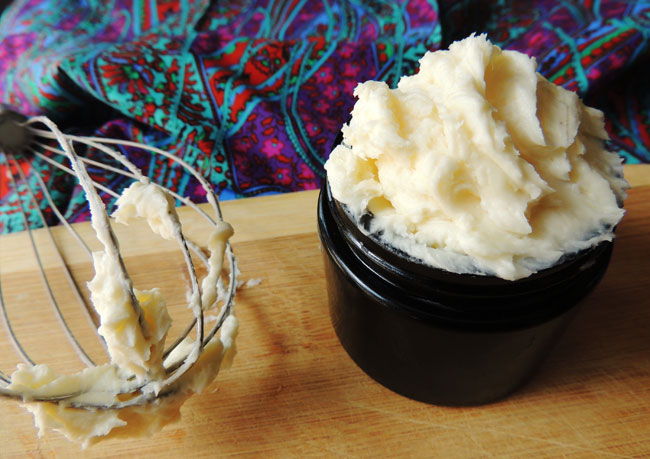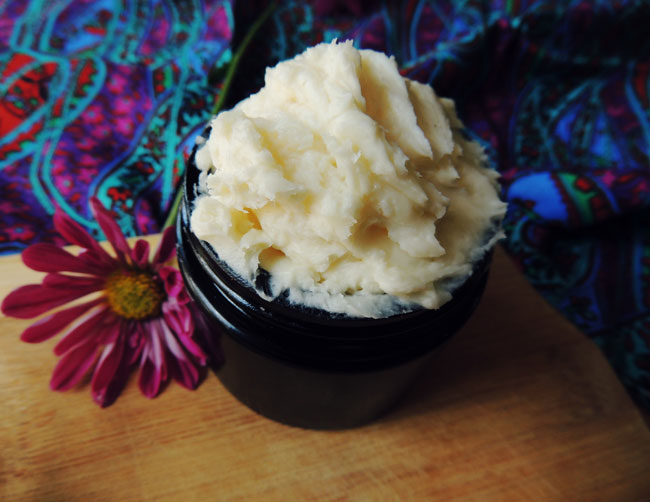You can go ahead and call it the "miracle mineral" if you want to, but all silly names and taglines aside, magnesium is a truly incredible nutrient. What more can you say about a mineral that is essential for the function of every single cell in your body? Learn how to make your own magnesium-infused body butter combining the healing benefits of lush cold-pressed coconut oil and organic cocoa butter, and scented with a splash of your favorite essential oils. Experience the benefits of transdermal magnesium therapy, while simultaneously replenishing the skin and delighting your senses: does it really get any better than that?

Why Magnesium Oil?
As one of the seven nutrients placed on the U.S. Department of Health's list of concern, it is clear that the alarming issue of rampant magnesium deficiency has finally made it to the mainstream. If you aren't all too familiar with magnesium, check out our post Are You Magnesium Deficient? to decide if you might be among the 200 million Americans that struggle with inadequate levels of magnesium. There are many overlapping and intricately woven causes that contribute to the epidemic of magnesium deficiency witnessed across the population today. These include such omnipresent concerns as mineral-depleted soils, poor diet, caffeine intake, chronic low-level stress and perpetual exposure to synthetic chemicals in the environment.
Another factor that complicates magnesium intake is the issue of malabsorption. Not only do magnesium-rich foods like nuts, seeds and legumes need to be properly soaked and sprouted to enhance mineral bioavailability, but the digestive tract must also be functioning optimally to assimilate it correctly. Unfortunately, neither of these things are very common in our era of processed foods and frequent antibiotic use. Confounding this issue further is the unfortunate fact that magnesium salts tend to have a laxative effect when taken in more concentrated amounts, making oral supplementation both unpleasant and inadequate. As explained by Dr. Norm Shealy, MD, "magnesium needs to travel through the intestinal system slowly, so if the gut transit time is less than twelve hours, one is not likely to absorb the magnesium well." Because oral magnesium has been shown to be only 35-40% effective, experts often recommend using transdermal magnesium oil instead.
Magnesium oil is a super-concentrated form of magnesium chloride that is effectively absorbed through the skin. Drawn from the Ancient Zechstein Seabed in Northern Europe, it is an an all-natural raw from of magnesium that is known for its superior solubility and has been shown to be a highly valuable method for replenishing cellular magnesium stores in a way that is gentle, rapid and safe. It can be conveniently applied to the skin in a spray, gel, lotion, or flakes that dissolve in a warm bath. Unlike the more common magnesium sulfate found in epsom salts, magnesium chloride is very readily taken in through the skin and transported to the cells in a form that is highly bioavailable by the body. What's more, when magnesium chloride is applied transdermally, the body self-regulates- absorbing only the amount it needs and neutralizing risks of excess supplementation, mineral imbalance and GI upset.
Magnesium for Sensitive Skin
All this praise having been boldly sung, some people purchase magnesium oil and enthusiastically spritz it all up and down their bodies, only to find that it is irritating to the skin. Because a slight mineral residue is sometimes left after application, those with particularly sensitive skin can experience an itching or tingling sensation after using the full-strength magnesium oil spray. For ladies who shave their legs, or for little kids with oh-so-soft skin, this can be a bothersome situation. Never fear however! This can easily be remedied by tweaking your routine a bit with one of the solutions below:
1. Spray magnesium oil on areas where the skin is tough and resilient (such as the feet).
2. Apply 20 minutes before showering. This way most of the magnesium ions will have absorbed fully into the skin by the time you hop in. It is also acceptable to wipe the skin clean with a damp towel about 20 minutes after application too.
3. Dilute the magnesium oil by mixing with an equal part filtered water prior to spraying it on the skin. Filtered water is best here, as you don't want to be rubbing chlorine all over your skin either!
4. Use a soothing and replenishing magnesium oil lotion or gel. I like Ancient Minerals Magnesium Lotion and Gel, because they are fragrance free and use a skin-nourishing base of all certified organic oils.
5. Make your own magnesium oil body butter!
Because all of the other steps are relatively self explanatory...and because DIY is in the title of the blog post, let's focus on option #5. For all you crafty do-it-yourselfers out there, here is a fun DIY magnesium body butter to try. I make up a few batches of this super moisturizing stuff to keep on hand in the spring and summer when my skin is extra-loved by the sun and rough from being out in the garden. It also works great as a mild all natural muscle rub for stubborn aches and pains. I store it in a small violiv jar and keep it in the fridge, so that it is extra cooling on a hot day. Thank you to Katie The Wellness Mama for the inspiration.
DIY Magnesium Body Butter

Ingredients:
1/4 cup organic extra virgin coconut oil
1/2 cup unrefined cocoa, mango and/or shea butter (You can find them at many health food stores or online. I use a blend of the different butters depending on what I have on hand.)
1/4 cup magnesium oil
essential oil of your choice (optional)
1. In a double boiler or over low heat, melt coconut oil and butters.
2. Pour into medium sized bowl and let cool at room temperature for about 30 minutes, or until it begins to get opaque.
3. Using a stand mixer or hand blender with the whipping attachment, start to whip together the oils.
4. Ever so slowly, begin to add in the magnesium oil until well combined. At this point you can also add essential oils of your choice. Keep in mind that not all essential oils are healthy for the skin or safe for kids and pregnant women to use.
5. Place in the refrigerator for about 15-20 minutes until it is semi-solid and then reblend. It is best to set the lotion in this way so that it whips up optimally- giving it a divinely fluffy texture.
6. Scoop into glass jars and store in the refrigerator. The body butter will be firm when you first start to apply, but melts nicely into the skin and absorbs rapidly. You can store out on the counter, however if the oils start to melt (usually occurring around 70 degrees or so) you will lose the whipped texture. Because the oils used are generally very stable, it should last for a few months.
If made by the above recipe, each tsp of lotion will contain somewhere around 250 mg of magnesium per tsp. Although history, diet, stress, physical exertion and other lifestyle factors all play a role in determining the amount of magnesium required by an individual at any given time, a general rule of thumb for daily supplementation is 3-4 mg of magnesium per pound of body weight.
Resources
Transdermal Magnesium Therapy by Mark Sircus Ac, OMD
The Magnesium Miracle by Carolyn Dean MD, ND
